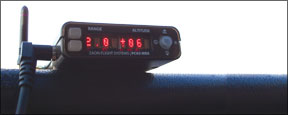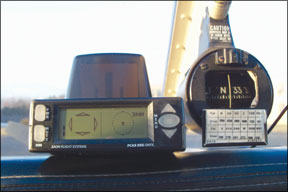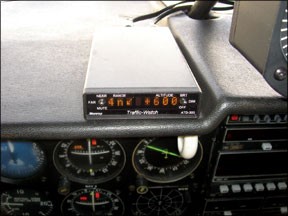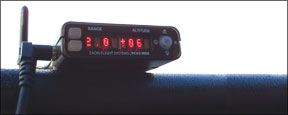There may not be widespread midairs out there, but we wiggle in our seats in busy airspace and non-controlled fields. If you fly a glider, rental or don’t have 10 grand in your budget for a traffic alerting system (TAS) install, a portable traffic system can fill the gap. But these arent active systems like TAS. Portable systems are passive, simply listening for 1090 MHz transponder transmissions of other aircraft. Some designs suffer from pulse suppression issues. The result is nuisance alerts that might have you reaching for the power switch in busy airspace. In a traffic-rich environment position accuracy is also a concern. Interpreting the data on a small screen-especially when its on top of the glareshield in a sun-splashed cockpit-is tough. Tying it to a portable GPS map screen solves this issue, but with added wiring clutter. Given that rules vary for LSAs and certified aircraft, we tested several configurations: Some connected to external L-Band antennas, some installed in the panel and some plopped on the glareshield (which became a projectile in turbulence). We tested in high-wing, low-wing and a helicopter. We also tested on the ground, evaluating effectiveness for spotting targets in the pattern before takeoff. We compared the units to on-board TIS and TAS systems for yet more drama. Our testing grounds was a slice of central Connecticut Class D airspace sandwiched between New Yorks Class B and Hartfords busy Class C. Finding threat targets to paint in any direction was not a problem. We admit to some tension.
Zaon PCAS models
PCAS stands for Portable Collision Alert System, and the PCAS XRX Onyx (used to be SureCheck) is the flagship offering with a street price just south of $1500. It did the best at spotting traffic of any in the test group and has the most features.
The XRX can play its traffic on everything from the Honeywell AV8OR or later-generation Garmin portables to Anywhere Map software. It also interfaces with LSA/experimental cockpit displays from Grand Rapids, Advanced Flight and others. The XRX is unique with display of target bearing and two configurable screen options, including a top-down, 3-D quadrant view. It has a serial port and an audio interface on the rear of the case (rugged power/data cable optional). Speaking of audio, the XRX offers tone or voice alerts that can be routed through headsets with a plug-in adapter which Zaon calls Headset Direct. It worked we’ll with our Bose headsets when the extra wires werent getting in the way.
We think the XRX traffic presentation and azimuth function is the most detailed of any of the portables. The unit detects and paints up to three target aircraft and bearing data is depicted with on-screen arrows. It also has intuitive menus for setting range-either one, three or six nautical miles as we’ll as relative altitude window of 500, 1500 or 2500 feet. You can even configure whether the host aircraft is a high- or low-wing. An optional ground mode wont show traffic less than 200 feet above. For traffic resolution, the system uses integral altimeter, compass and turn and bank, and thermal sensors. As a result, there’s display of local squawk code, altitude, bank angle, bearing
and temperature offering some critical and useful flight data. It even works in a pressurized cabin.
If you are looking for a low-profile and inconspicuous model, the XRX has a small footprint but there’s an awkward signal amplitude/phase cancellation antenna protruding from the top of the case. In fact, we struggled to find a good way to keep the XRX in place and forward facing when jumping from aircraft to aircraft. Proper placement on the glareshield is critical to bearing resolution and you need to be careful mounting the unit too close to the structure. Zaon warns of potential aft-shadowing in metal airplanes-up to 60 percent in some cases. In the XRXs defense, we didnt use the included Velcro mounting dots or silicon feet during our testing.

Despite its awkward shape, the XRX stamps a small footprint. Its intuitive, back-lit LCD display is unfortunately difficult to view in direct sunlight. Connecting to a portable map display would be worthwhile.
Operating on and around a traffic-packed instrument approach in a Skylane, the unit was busy calling other targets above and below coinciding with the onboard TIS datalink transponder. It missed a Regional Jet that was smoking along and quickly catching up to us on the localizer. We assume it was that aft-shadowing Zaon warns of.
For a shirt-pocket option, we like the Zaon MRX. The MRX is about the size of a deck of cards and its shape makes it possible for in-panel mounting, unlike the XRX. It also only costs about $500. You can operate the MRX on a couple of AA batteries or plug into ships power. The MRX wont work in pressurized cabins since it uses an integral altimeter to determine the local altimeter setting.
The tiny MRX had a high-quality feel, and we were impressed with the portable antenna and right-angle RF connector. We flew the unit stand-alone and in a Piper that had a dedicated L-Band blade-style antenna, affording the best potential performance. There were some limit-ations and the unit offered some head-scratching bogus call-outs. We wondered if it was our own pulse it was calling. ATC confirmed there was no traffic in our vicinity.
Monroy ATD-300
A pioneer in portable traffic devices, the Monroy ATD-200 was the first low-cost semi-portable The product has matured into the $795 ATD-300 Traffic Watch+, which is a similar design that has PMA and STC approval. For existing ATD-200 setups, you can easily drop in the newer ATD-300.
There are two versions of the ATD-300. The Plug-and-Fly kit simply plugs into the cigarette lighter plug and uses a portable antenna. Plug and Fly is limited to calling transponder replies and distance only and has a range of five nautical miles. For directional information on the traffic, Monroy offers the ANT-300 external L-Band fiberglass antenna.
The small ATD-300 resembles an automotive radar detector. Its simple to operate with a simple display that tracks one threat at a time. We like the easy-to-interpret high-vis display of the Monroy, but were less impressed with the units performance. The unit we sampled was panel-mounted and interfaced with an external antenna.

As with the earlier ATD-200, the unit seemed to pick up host transponder replies even when connected with a Comant blade-style external antenna. To be fair, there wasnt much separation between the traffic antenna and the transponder antenna and neither had shielded low-loss coax. These are important points with a permanent installation.
The ATD-300 provides distinctive female voice warnings for traffic at different ranges. For instance, when the unit is set in the far mode, targets at three miles and 1000 feet is annunciated as “Traffic.” When set in the near mode, only traffic within one mile and 500 feet is annunciated as “Traffic nearby.” When there is no traffic activity, the ATD-300 automatically displays the onboard Mode C altitude data and bus voltage monitor. The ATD-300 can display on panel-mounts, such as Garmin 430/530s and Aspen PFD/MFDs.
Proxalert R5
We tested the R5 in our last portable review back in 2007. It performed we’ll and was rich with functions, such as an altitude-deviation alerter. Its designed for mounting on top of the glareshield and uses a portable L-band antenna. Aircraft Spruce sells it for $795.
But we couldnt get through with the company for a fresh sample or get updated information. No matter how good a product may be, its nothing without prompt factory support when needed. Caveat emptor.
NavWorx PADS600
We covered the NavWorx PADS600. in our ADS-B roundup in the October 2010 issue. The $1495 PADS600 receives TIS-B broadcast traffic and displays the targets on a variety of third-party displays, including Garmin portable GPS units. NavWorx told us, however, they arent focused on portable ADS-B but instead on fully TSOd, mandate-compliant systems. This has us contemplating the longevity of the PADS600.
Panel Mounting?
To avoid lugging the system around, and to potentially improve performance, permanently mounting one of these systems is tempting. This is seldom easy or inexpensive and might not be legal.
The PMA-approved Monroy ATD-300 has an STC for limited applications, which may help. But ultimately, its up to the installing shop whether any installation requires official approval. Interestingly, the Non-TSO/Non-STCd Zaon MRX has a complete section in its installation guidelines offering advice on return-to-service approval options. It makes no promises, but Zaon offer an impressive bundle of install hardware to get the physical job done.
As we noted, the best performance comes from connecting the portable to an external antenna. If your aircraft has an abandoned transponder or DME antenna system remaining on the airframe, you might be in luck as long as the system doesnt have any defects. Otherwise, the install cost will depend on how much interior must come out.
Conclusion
We thank Sportys for supplying some of our test units. They told us sales of the Zaon XRX system with the optional Garmin interface cable is way up and we can see why. We found the XRX and smaller MRX to be solid performers.
None of the portables perform as we’ll as a real TAS or TCAS system. You cant expect them to. However, a portable can be better than a TIS datalink system at times due to coverage holes. A portable also works on the ground.
We think the Zaon XRX coupled to a third-party display is the best the portable market has to offer. But its also the priciest and has the most cabling to deal with. Best case is the XRX connected to the GPS thats in a Gizmo dock where you can hide all those wires behind the panel. Worse case is putting both units on top of the glareshield while creatively routing the wires. If thats more cost or trouble than you want, our advice is a stand-alone MRX. It should get the job done for little money.





